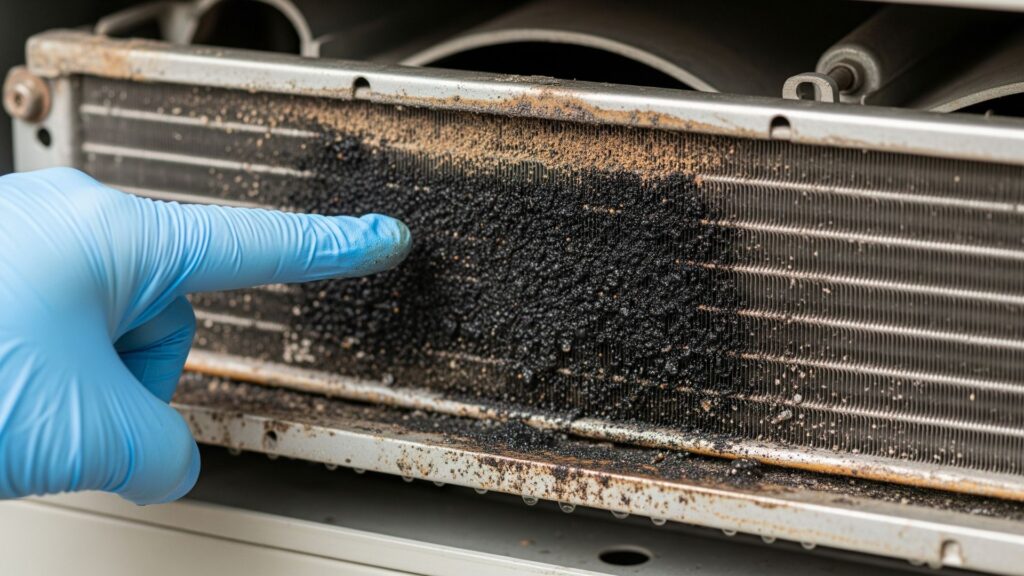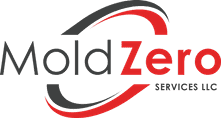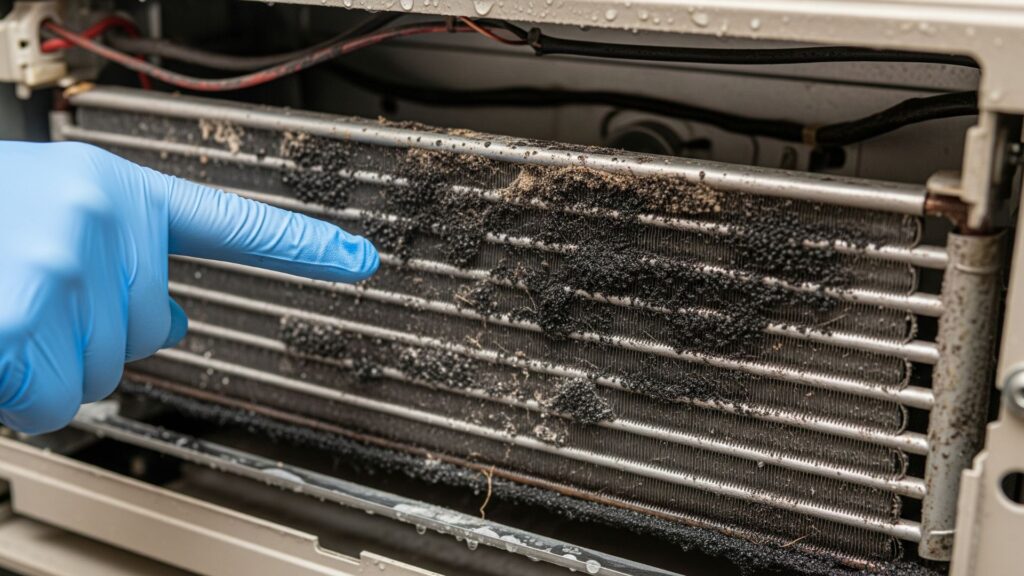Why Your AC is a Prime Location for Mold Growth
Your air conditioning system is designed to provide comfort, but its fundamental operation creates an ideal environment for mold development. The combination of moisture from condensation, darkness within the ductwork and unit, and the presence of organic materials like dust and debris provides everything mold needs to flourish. When you notice a problem, it’s often a sign of a more significant issue hidden from view. For property owners in Los Angeles, addressing this issue quickly and correctly is crucial for protecting your investment.
At Mold Zero, we have addressed mold issues in over 1,000 properties, and we understand the unique challenges that AC systems present. Our NORMI certified professionals specialize in a comprehensive approach that resolves the current problem and helps you maintain a better indoor environment for the future.
The Science Behind AC Mold
Every time your air conditioner runs, the evaporator coil gets cold to cool the air. This process causes moisture from the warm, humid air to condense onto the coils, much like a cold glass of water on a summer day. This water is supposed to collect in a drain pan and flow out through a condensate line. However, if the line is clogged or the pan is not sloped correctly, water can pool inside your air handler.
This standing water, combined with the dust, skin cells, and other microscopic organic matter that gets pulled into the system, creates a perfect breeding ground. The dark, enclosed spaces of the air handler and ductwork protect this growth from UV light, allowing it to spread unchecked through your central air system mold network.
Common Areas for Mold Within Your HVAC System
While mold can appear anywhere, certain components are more susceptible. The evaporator coils and the drain pan are the most common culprits due to the constant presence of moisture. The insulation inside the air handler can also become a major problem area, as it can absorb water and is made of organic material. From there, the blower fan can distribute mold spores throughout your entire property via the ductwork, leading to growth on supply vents and registers in various rooms. Understanding these high-risk areas is the first step in a proper inspection, which is why a professional assessment is so important for identifying the full scope of the issue.
Identifying Mold in Your Air Conditioning System
Detecting mold in your HVAC system early is key to preventing a more extensive and complex problem. Often, the first sign is not something you see, but something you smell. Trust your senses; they are your first line of defense. If you suspect you have mold in your air conditioner, a prompt and thorough inspection is the most important action you can take. Ignoring these early warning signs allows the issue to worsen, potentially affecting more of your property and making the resolution process more involved. As Los Angeles’s trusted experts, we urge homeowners and business owners to be vigilant and aware of these common indicators.
The Unmistakable Mold Smell from AC Vents
One of the most frequent complaints we receive is about a persistent musty or earthy odor, often described as smelling like dirty socks or a damp basement. This distinct mold smell from AC vents is most noticeable when the system first kicks on, as the initial burst of air pushes the concentrated odors out into your living or working space. This smell is caused by Microbial Volatile Organic Compounds (MVOCs), which are gasses produced by mold as part of its metabolic process. If you only notice this smell when the AC is running, it’s a very strong indicator that the source of the problem is located within the unit or its associated ductwork.
Visual Clues on Vents and Units
While much of the growth happens out of sight, you can sometimes find visual evidence. Carefully inspect the air supply vents in your rooms. You might see small black, green, or white specks on the grill or feel a slimy substance. This is a clear sign that mold spores are being distributed through your system. You can also check the area around the indoor air handler. Look for any signs of water staining, condensation, or visible growth on the exterior of the unit. For a mold in window AC unit, you may see discoloration or fuzzy growth on the front louvers or deep inside where the cool air comes out. These visual signs mean immediate action is required.
Changes in Your Indoor Environment
Sometimes, the signs are more subtle and relate to the overall feeling of your indoor space. You might notice that the air feels unusually damp or humid, even when the AC is running. Occupants might mention that they feel better when they are away from the property for extended periods. While many things can influence this, a sudden change that coincides with AC usage can point toward a mold issue that is impacting the overall quality of your indoor air. Addressing the source within the HVAC system is the only way to resolve these persistent environmental concerns.
The Impact of AC Mold on Your Los Angeles Property
Discovering mold in your air conditioner is more than just an inconvenience; it’s a direct threat to the structural integrity and value of your property. At Mold Zero, we focus on helping property owners understand these risks so they can take decisive action. The presence of mold, especially central air system mold, can lead to a cascade of problems that devalue your home or business and can result in costly repairs if not addressed properly. Our process is designed not only to address the mold but to protect your property from the invasive and often destructive methods used by other companies. We prioritize a minimally invasive approach that respects your space and investment.
Structural Component Degradation
Mold’s primary function in nature is to break down organic material. When it grows unchecked inside your walls or HVAC system, it does the same thing to your property. It can feed on the paper backing of drywall, wooden support beams, and organic-based insulation. Over time, this can weaken these materials, leading to serious structural concerns. The moisture that allows the mold to grow in the first place can also cause wood to rot and drywall to crumble. A small leak in a condensate line hidden within a wall can lead to extensive damage that requires significant rebuilding, far beyond the cost of the initial mold remediation.
Reduced HVAC System Efficiency and Lifespan
Mold growth on evaporator coils and blower fans acts like an insulating blanket, forcing your system to work harder to cool your property. This reduces its efficiency, leading to significantly higher energy bills. The added strain also causes premature wear and tear on critical components like the compressor and fan motor, shortening the lifespan of your expensive HVAC equipment. Furthermore, the acidic byproducts of mold growth can corrode metal parts, including the delicate fins on the coils, permanently damaging the system. Professional HVAC mold remediation is an investment not just in your property’s air, but in the longevity and performance of the system itself.
Addressing Mold in Window Units vs. Central Air Systems
The approach to resolving a mold issue differs significantly depending on the type of air conditioning you have. A small, self-contained window unit presents a different set of challenges than a sprawling central HVAC system that connects every room in your property. As NORMI certified professionals with experience in over 1,000 remediation projects, we have the expertise to handle both. Understanding the differences is key to appreciating why a one-size-fits-all solution is ineffective and why professional intervention is critical, especially for the complexities of central air.
The Challenges of Mold in a Window AC Unit
A mold in window AC unit might seem like a simpler problem, but it requires careful handling. These units are compact, and mold can grow deep within the coils, fan, and styrofoam casing, making it very difficult to access and address completely. Simply spraying the visible surfaces is not enough. The entire unit often needs to be disassembled for a thorough treatment, a process that can be complicated and risks damaging the components if not done correctly. While the problem is contained to one unit, running it can still distribute a high concentration of spores into a single room. For landlords and homeowners in Los Angeles, ensuring a window unit is properly addressed is crucial for the well-being of occupants.
The Complexity of Central Air System Mold
Central air system mold is a far more complex and serious issue. The system’s ductwork acts as a network, spreading mold spores from a single source, like the air handler, to every corner of your property. This means that addressing the growth on the coil or in the drain pan is only part of the solution. The entire duct system must be assessed and, if necessary, treated to resolve the problem comprehensively. This is not a DIY job. It requires specialized equipment and a deep understanding of HVAC mechanics and airflow dynamics. Attempting to manage this on your own often results in cross-contamination, making the problem worse. This is where professional HVAC mold remediation becomes absolutely essential.
The Definitive Guide to Professional HVAC Mold Remediation
When faced with an AC mold issue, choosing the right resolution path is the most important decision you will make. While the temptation to try a quick fix is understandable, the complexities of HVAC systems mean that improper attempts can spread the problem and fail to address the root cause. Mold Zero provides a definitive, professional solution designed for maximum effectiveness with minimal disruption. Our unique 5-step process, 1-Year Guarantee, and commitment to third-party verification set the standard for mold remediation in Los Angeles. We offer a true resolution, not a temporary cover-up.

Why DIY AC Mold Removal Often Fails
Many property owners attempt to address AC mold with store-bought sprays or by wiping down visible surfaces. This approach is destined to fail for several key reasons. First, it doesn’t address the hidden growth deep within the coils, blower, or ductwork. Second, disturbing mold without proper containment protocols can release a massive amount of spores into your property, potentially creating new problem areas. Finally, DIY methods don’t fix the underlying moisture issue that allowed the mold to grow in the first place. Without correcting the cause, the mold will simply return, wasting your time and effort and allowing the risk to your property to continue.
Our 5-Step Process: The Mold Zero Difference
Our proven methodology ensures a thorough and lasting solution. We have refined this process over more than 1,000 successful remediation jobs to be fast, efficient, and minimally invasive, allowing you to get back to your life quickly. We believe in a comprehensive approach that addresses every aspect of the problem. Our process is designed to be completed in hours, not days, respecting your time and property.
- Step 1: Comprehensive Inspection. Our NORMI certified experts conduct a detailed assessment to identify the source of the moisture and the full extent of the mold growth, including hidden areas within the HVAC system.
- Step 2: Containment and Air Filtration. We establish critical containment barriers and use powerful air scrubbers to prevent any cross-contamination to other areas of your property during the remediation process.
- Step 3: Targeted Mold Treatment. We apply our advanced solution that neutralizes mold on contact. Our method is designed to penetrate deeply into porous and non-porous materials without the need for costly and destructive demolition.
- Step 4: Addressing the Source. We work to correct the underlying moisture issue, whether it’s a clogged condensate line, poor drainage, or high humidity, to prevent the problem from recurring.
- Step 5: Final Verification. We don’t just tell you the job is done; we prove it. This final, crucial step sets us apart and provides you with complete confidence in the results.
The Importance of Third-Party Verification
Trust is paramount in our industry. That’s why we conclude every project with independent, third-party lab testing. After our work is complete, an unaffiliated testing company takes air and surface samples and sends them to a lab for analysis. This provides you with unbiased, scientific proof that the mold issue has been successfully resolved to industry standards. This level of authoritativeness and transparency is a core part of our commitment to our clients and a key reason why we are the trusted mold experts in Los Angeles and San Marino.
Our 1-Year Guarantee: Your Peace of Mind
We stand confidently behind our work. Mold Zero offers a 1-Year Guarantee on all our remediation projects. If any of the same mold returns in the treated area within one year, we will come back and address it. This guarantee is our promise to you that we provide a lasting solution, not a temporary fix. It reflects our expertise, the effectiveness of our 5-step process, and our dedication to your long-term satisfaction and the well-being of your property.
Long-Term Strategies for Preventing Mold in HVAC Systems
Once your system has been professionally addressed by Mold Zero, the focus shifts to prevention. A proactive approach is the best way to ensure your air conditioner remains a source of comfort, not a source of mold. Implementing a few key strategies for preventing mold in HVAC systems can save you significant time, money, and stress in the long run. These steps help manage the conditions mold needs to grow, primarily moisture and organic debris, keeping your system running cleanly and efficiently.
Routine Maintenance and Inspections
Regular professional maintenance is the single most important step in preventing AC mold. We recommend having your HVAC system serviced by a qualified technician at least once a year, preferably before the cooling season begins. A technician will clean the coils, check the drain pan, and ensure the condensate line is clear and flowing freely. They can spot potential issues before they become major problems. Between professional visits, you should change your air filters regularly, typically every 1-3 months. Using high-quality pleated filters can capture more dust and organic particles, effectively starving mold of its food source.
Managing Indoor Humidity Levels
Your air conditioner is a dehumidifier, but it can sometimes struggle to keep up, especially in a humid climate or a tightly sealed property. High indoor humidity creates an environment where mold can thrive, not just in the AC but throughout your home. Consider using a standalone dehumidifier in particularly damp areas like basements. Ensure that exhaust fans in bathrooms and kitchens are vented to the outside and are used every time you shower or cook to remove excess moisture from the air. Keeping your indoor humidity level below 50% is an excellent target for mold prevention.
Take Control of Your Indoor Environment Today
The presence of mold in your air conditioner is a serious issue that requires a professional and comprehensive solution. Ignoring the signs or attempting an incomplete DIY fix can lead to greater property damage and a more complex problem down the road. As Los Angeles’s premier mold remediation specialists, Mold Zero has the experience, technology, and proven process to resolve your AC mold issue quickly and effectively. With over 1,000 successful projects, a 1-Year Guarantee, and results verified by independent labs, we provide the peace of mind you deserve.
Your Next Step: A Free, No-Obligation Inspection
Don’t wait for the problem to get worse. If you’ve noticed a musty odor, seen visible signs of growth, or suspect you have an issue with your window AC or central air system, the time to act is now. We offer a free, no-obligation inspection to property owners throughout Los Angeles and surrounding areas like San Marino. A NORMI certified expert from our team will assess your situation, identify the source of the problem, and provide you with a clear, upfront quote for a complete solution.
Partner with Los Angeles’s Trusted Mold Experts
Protect your property and your investment by choosing the right team for the job. Our minimally invasive process is designed to be fast and effective, resolving most issues in just hours, not days. We treat your property with the respect it deserves, using solutions we would trust in our own homes. Take the first step toward a better indoor environment. Call Mold Zero Services LLC today at (626) 671-8885 to speak directly with a specialist, or fill out the online form on our website to schedule your free inspection and quote.

